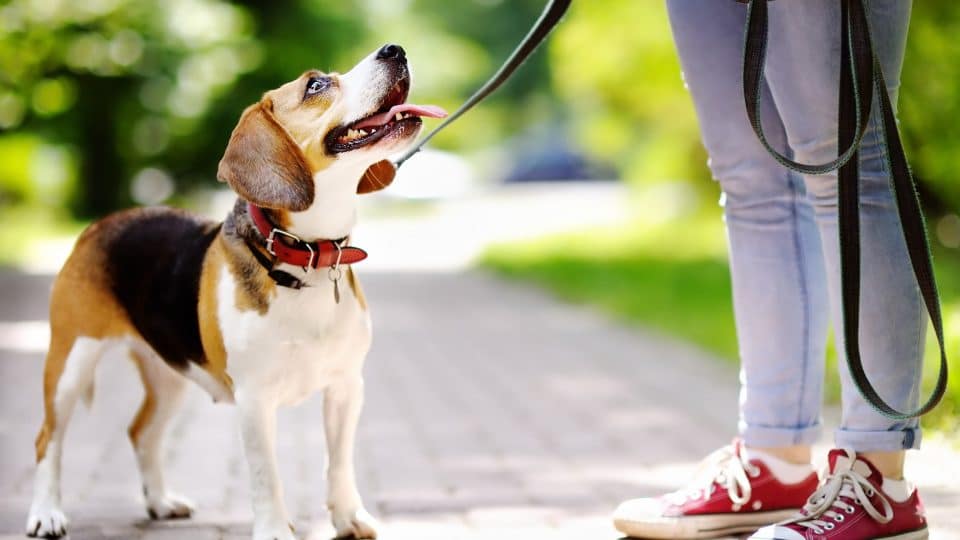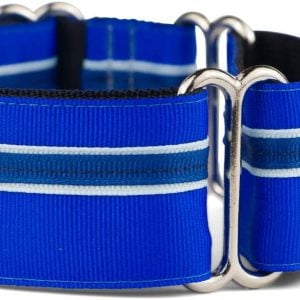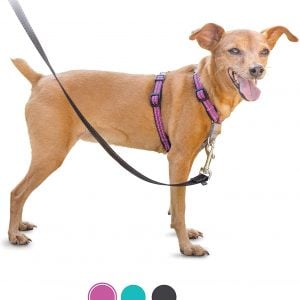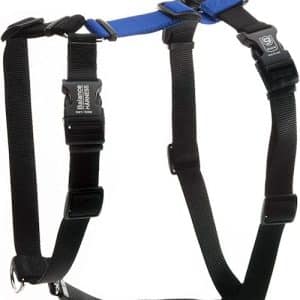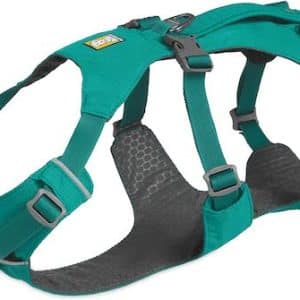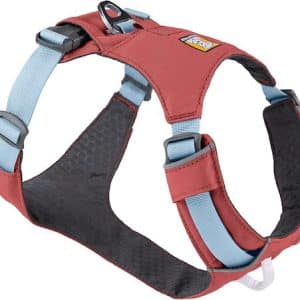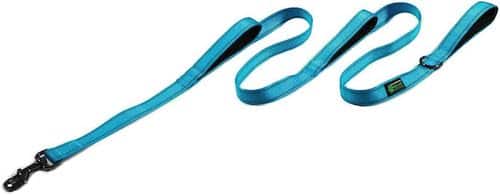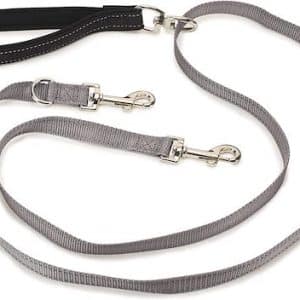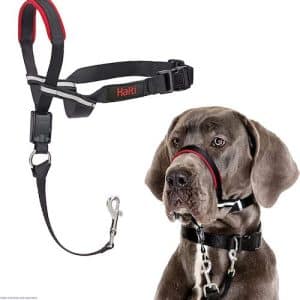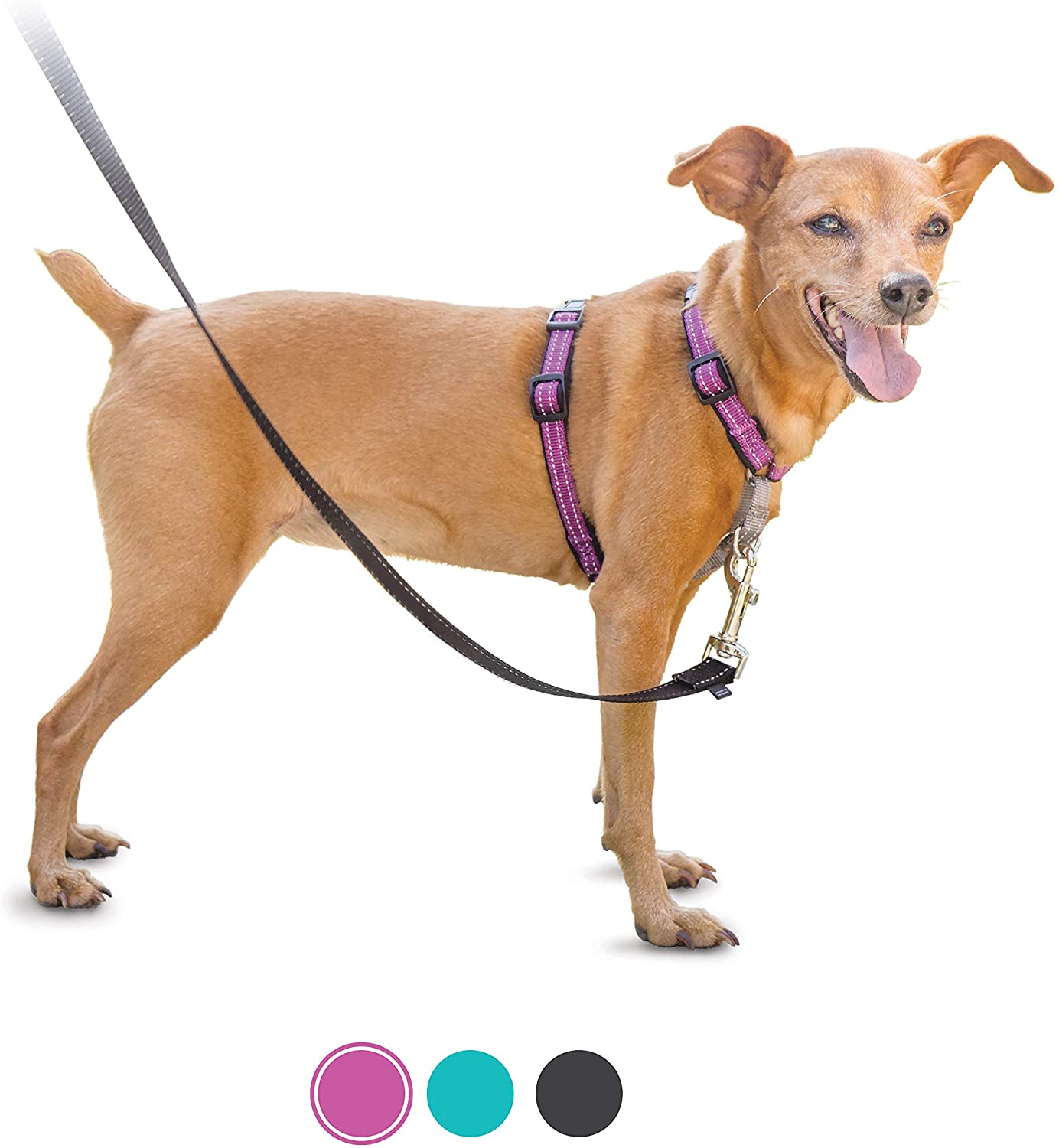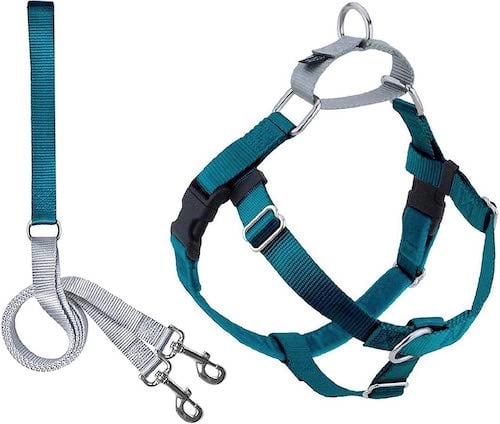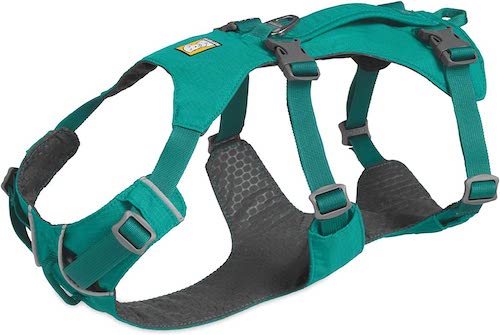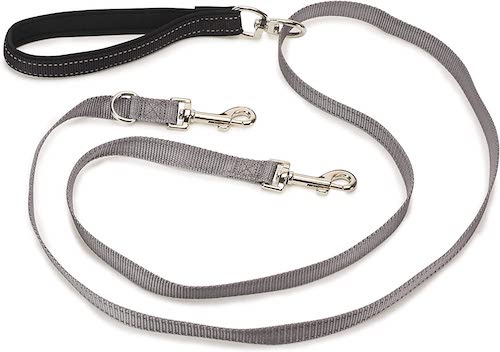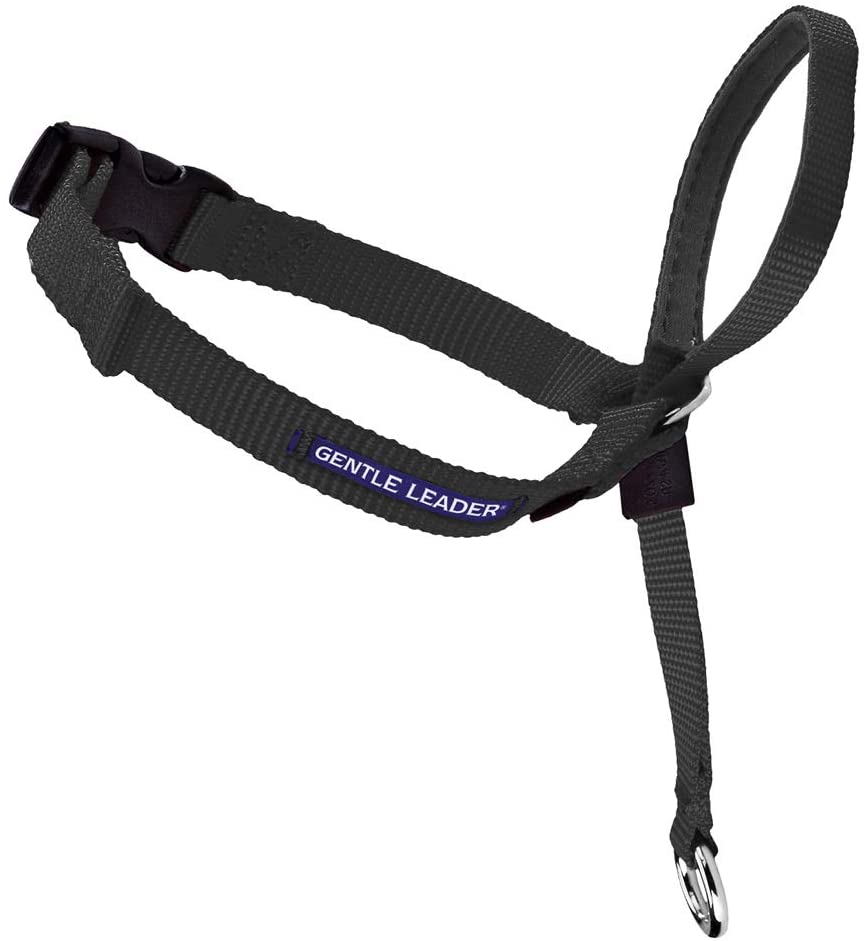- This review contains affiliate links. Read more here.
- Not a substitute for professional veterinary help.
Your local pet supply store and online pet retailers are full of flashy dog collars and leashes, but not all are ideal for training your dog to walk nicely. Whether you have a puppy, an adult rescue, or an experienced walker who’s picked up some bad habits (like pulling or reactivity), the right gear can help your training.
Since every dog has different requirements, we consulted a trainer and a veterinarian for advice on choosing the best harness, dog training collar, and leash to cultivate good walking habits. These tools will speak to specific needs and dog types. So don’t worry if you have a challenging walker—we have some training tool ideas to help get them walking like a pro.
Our picks
Best Dog Training Collars
The best dog training collars will be comfortable, secure, and adjustable for a precise fit. Our experts recommend a safe, flat design instead of choke or prong collars, which cause unnecessary pain and may lead to suppressed feelings and negative behavior.
“Positive reinforcement techniques and humane training tools are generally more effective and considerate of the dog’s well-being,” explains Dr. Kathryn Rosalie Dench, a veterinary surgeon and advisor for Gentle Dog Trainers. Here are three solid choices.
Best Collar for Puppy Training: Blueberry Pet Soft & Safe Collar
Ideally, puppy collars will be lightweight and comfortable for young trainees getting used to wearing gear. A simple flat collar combined with positive reinforcement is a great way to start building the foundation for walking nicely on a leash.
This Blueberry Pet collar provides a secure fit without being too restrictive. It features soft neoprene padding and a tri-glide buckle that allows for easy size adjustments as your pup grows. The unobtrusive design also makes this collar suitable for wearing alongside a harness during training.
For safety, the collar includes a loop for hanging ID tags and reflective threading for visibility (handy for taking your young pup out during the night for potty breaks).
Features we like:
- Padded and lightweight
- Includes loop for hanging tags
- Reflective stitching along polyester webbing
- Comes in several attractive colors
- Buckles are made with eco-friendly plastic
Things to consider:
- For pullers, collars should be used with a harness
Best Martingale Training Collar: Max and Neo Martingale Collar
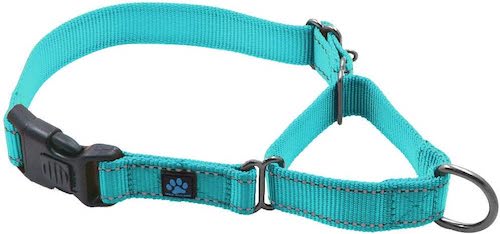
Max and Neo Martingale Collar
This lightweight martingale collar tightens gently to restrain wriggly pups and discourage pulling.
Along with simple flat collars, some dog training experts and vets recommend martingale collars. “These collars provide control without causing discomfort or injury to the dog when used correctly,” explains Dr. Dench. Also known as a “limited-slip collar,” martingale collars tighten slightly when a dog pulls to prevent them from slipping out.
The martingale loop on this Max and Neo collar prevents runaway pups from wriggling free, while the nylon fabric is lightweight and durable. It’s also adjustable and comes in six sizes, so it’s well-suited for small and large dogs alike.
It’s worth noting, however, that martingale collars are intended for training and shouldn’t be worn all day. While they’re a safe tool, the extra loop can get caught on things, so you’ll want to supervise your pup when they’re wearing one.
Features we like:
- Lightweight and comfortable
- Lockable tab on buckle prevents accidental release
- Plastic tab is provided for tags
- Reflective trim along both edges of the collar
- For every purchase, the company donates a collar to a rescue
Things to consider:
- There are some complaints about the tag attachments breaking
- Not for all-day use
Best Martingale for Escape Artists: If It Barks Martingale Collar

If It Barks Martingale Collar for Dogs
This wide martingale collar prevents escape artist dogs from slipping out by tightening up when the dog pulls.
Along with dogs inclined to pull, martingale collars are great for dogs with small heads and long necks (such as greyhounds and whippets) who may slip out of regular collars. Additionally, they’re useful training tools for anxious rescues or shy dogs who may attempt to back out of their collar on walks.
The slightly wider width of this collar makes it ideal for a sighthound’s anatomy. The nylon webbing is made to military specs, lending this collar strength and durability. Even so, it’s about half the thickness of most nylon collars, meaning your dog won’t be weighed down by it.
While it’s not cheap, your investment is protected with the “If It Barks Warranty,” which replaces any collar if the stitching or hardware fails with regular use.
Features we like:
- Perfect for training escape artists and dogs with small heads
- Applies even pressure around the neck to reduce the risk of choking or injury
- Handmade in the U.S.
- Works for a range of neck sizes
- Comes in 10 attractive color combinations
Things to consider:
- Martingale collars aren’t recommended for round-the-clock use
- Not for heavy pullers
- On the pricier side
Best Harnesses for Training Dogs
Walking a dog with a harness, which can be used with a collar, is often a more comfortable option. This is especially true for heavy pullers who could put some dangerous pressure on their necks if training with a collar. According to Julie Burgess, CPDT-KA, a certified dog trainer at Senior Tail Waggers, training with a harness eliminates strain on a dog’s neck, trachea, and even eyes.
The right harness can help dogs master loose-leash walking, especially if used alongside positive reinforcement training methods. Here are our top picks.
Best Harness for Training Puppies: PetSafe 3-in-1 Harness
Because puppies are inexperienced and many new situations may frighten them, trainer Julie Burgess advises choosing an escape-resistant harness they can’t back out of. Dr. Dench also recommends lightweight harnesses with multiple adjustment points to accommodate a puppy’s growing body.
While we reviewed the PetSafe Easy Walk, another popular harness from the brand, this particular model has some qualities we think make it a standout for puppies. First, it features neoprene-padded straps for comfort while discouraging puppies from attempting a getaway. The harness also has five points of adjustment that allow for size changes as your puppy grows.
The 3-in-1 is a versatile harness for all types of situations. It has a front leash attachment to discourage pulling and a standard back leash attachment for casual walks once your puppy has learned not to pull. A handle on the back gives you extra control when you need it, or you can use it to give your puppy a boost when their little legs need help.
Features we like:
- Versatile design: attachments for chest, back, or car
- Lightweight yet durable nylon
- Top handle provides quick control
Things to consider:
- Reviewers note the sizes tend to run big
Best Harness for Adult Rescues: Blue-9 Balance Harness
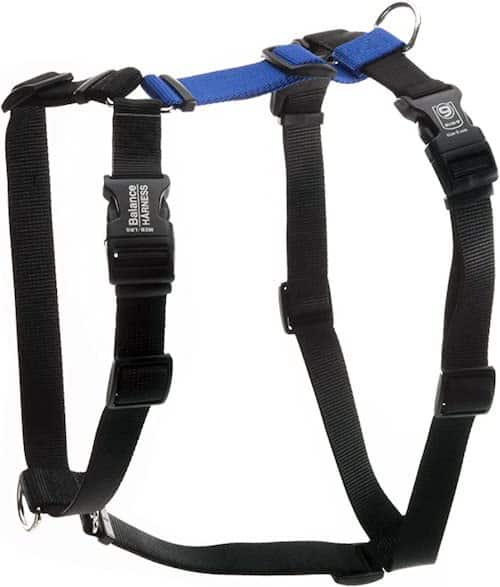
Blue-9 Balance Harness
The Blue-9 Balance has a minimal belt design that doesn’t need to go over the head, which may be preferable for nervous rescue dogs.
Adult rescue dogs may be new to training gear, which can translate to anxiety around wearing a harness. For these hesitant pups, something simple, comfortable, and easy to put on and take off is usually best.
This Blue-9 Balance Harness has a lightweight, minimal belt design. With buckles on the back strap and neck strap, it doesn’t have to go over the head, which nervous dogs may prefer. A contrasting color on the back strap makes it easier to visualize how the harness should go on your dog—creating a speedier process that’s better for dogs who find suiting up unnerving.
“For a mature rescue dog who needs training in the basics, a no-pull harness with a front attachment would be suitable,” Dr. Dench adds. The Blue-9’s dual rings make it perfect for training dogs not to pull. You can use the front ring alone or both simultaneously for extra control.
Features we like:
- Six points of adjustment fit breeds of all sizes
- Suitable for larger dogs
- Allows for a full range of motion
- Made with durable nylon
Things to consider:
- Some pet parents report that the straps can easily get twisted
Best Harness for No-Pull Training: 2 Hounds Design Freedom No-Pull Harness
“No-pull harnesses are great for experienced dogs with some bad habits, especially pulling on a leash,” says Burgess, adding that the lead can be hooked up in the front of the dog’s chest or mid-back. “You’ll need to experiment to determine which setup your dog walks the best with.”
This popular Freedom harness has two attachment points—one on the back and one on the chest. You can attach your own leash with the front attachment for no-pull training or use the included double-ended training leash with the front and back clips for extra control. Durable materials, like stainless steel hardware and heavy-duty nylon, are designed to withstand strong pullers.
Features we like:
- Martingale loop prevents dogs from escaping
- Soft lining prevents chafing
- Front strap is positioned to prevent choking (above the leg muscles, below the trachea)
Things to consider:
- At four feet, the least attachment is considerably shorter than most
Best Harness for Reactivity Training: Ruffwear Flagline Harness
Does your dog bark or lunge at other dogs, humans, or wildlife on your walks? Along with proper training, a good harness goes a long way in helping with leash reactivity. For extra control when faced with triggers, the Ruffwear Flagline sports dual leash clips that allow you to use a double lead.
A second belly strap and multiple adjustment points make this harness virtually escape-proof—essential for dogs who stop at nothing to get at what’s provoking them. There’s even a handle on the back that lets you quickly restrain your dogs during big reactive moments.
If you have an especially strong pup with big feelings, Ruffwear also makes the Webmaster harness, which has a similar design but with thicker padding. We tested this harness and found it to be a sturdy option for powerful pups.
Features we like:
- Six points of adjustment
- Three leash attachment points: chest, mid-back, and rear back
- The shell fabric has been updated for greater durability
- Padded handle for extra control
Things to consider:
- May be too bulky or long for smaller dogs
Best Training Harness for Brachycephalic Breeds: Ruffwear Hi & Light Harness (Verified Review)
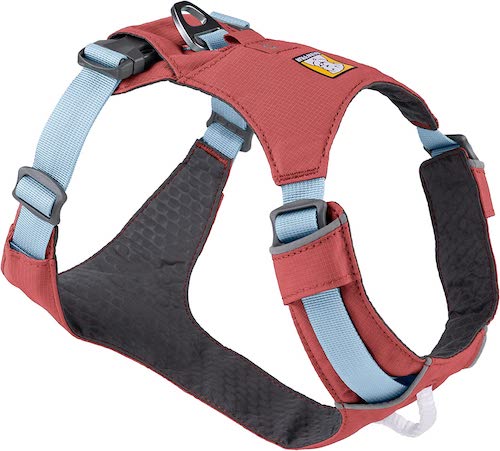
Ruffwear Hi & Light Harness
Ruffwear’s Hi & Light harness is a lightweight option for flat-faced breeds prone to overheating.
Flat-faced breeds, like Pugs and Frenchies, are prone to overheating and can have trouble breathing. These dogs need a harness that distributes pressure evenly across the chest to avoid dangerously restricting their airways.
Ruffwear’s Hi & Light harness has a minimalist profile and an ultra-lightweight feel, ideal for training your brachycephalic pup.
In our testing, we loved how easily the harness was to customize, with the same size fitting two differently shaped test pups like a glove (a short and stout Beagle and a long, leggy Lab mix). Four adjustment points allow for a custom fit that doesn’t feel restrictive on your dog’s fragile airways, and a sturdy aluminum V-ring centered on the back makes for comfortable walking.
Features we like:
- Lightweight and unrestrictive
- Includes a pocket for storing ID tags or dog waste bags
- Side-release buckles for easy on-and-off
- Debris-resistant liner keeps it cleaner for longer
- Bright fabric and reflective trim improve visibility
Things to consider:
- May not work for heavy pullers
Best Leashes for Training Dogs
According to Dr. Dench, the best leash for training walking is between 4 to 6 feet long. “This length allows for good control and communication between the handler and the dog,” she explains. Look for a leash made with durable materials (nylon and leather are frequently recommended) that won’t break under the pressure of pullers or reactive dogs.
Our experts also recommend avoiding retractable leashes during training. “Retractable leashes can make it difficult to maintain consistent control and may give the dog too much freedom, hindering the training process,” says Dr. Dench.
Best Leash for Training Puppies: Ruffwear Front Range Leash
When training a puppy to walk, a lightweight yet durable leash like this nylon Ruffwear lead is the way to go. Pet parents of young learners especially like the patented Crux Clip, which adds an extra locking mechanism for wriggly and rambunctious young pups. The traffic handle near the collar attachment also comes in clutch to help keep excitable puppies out of harm’s way.
Handy features include a built-in loop to attach poop bags, keys, and other accessories. The padded handle also makes long training walks more comfortable.
Features we like:
- Available in an array of colors
- A built-in accessory loop offers a safe place to attach keys
- Lightweight feel
- The 5-foot length is perfect for training
Things to consider:
- Some find the second handle too close to the collar
Best Leash for Training Adult Dogs: Max & Neo Triple Handle Leash
For safely training adult dogs, this reflective Max and Neo leash features triple handles. The longer handle allows for more slack for loose leash walking, while the shortest handle keeps your dog close in crowded or high-traffic situations. Placed at the 44-inch mark on the leash, the middle handle is in an ideal position for dogs who pull.
This leash is also constructed with heavy-duty nylon to handle the largest dog breeds. At the same time, it’s still soft and comfortable for the handler. A durable metal clasp protects against escape.
Features we like:
- Handles are padded with neoprene
- Thick but soft nylon webbing
- Includes a D-ring near the handle for clipping accessories
- Strong, durable hardware
- Available in seven colors
Things to consider:
- Though it only weighs 7 ounces, some reviewers say the leash is a bit heavy for smaller dogs
Best Double-Ended Leash: PetSafe Two-Point Control Leash
If you’re working with a reactive dog, a double-ended leash can give you more control. This PetSafe leash connects to dual-clip harnesses to reduce pulling and safely redirect your dog. To use as a standard 4-foot leash, this can be converted by clipping one end to the other.
Features we like:
- Swivel hardware prevents tangling
- Free-floating handle adjusts to your dog’s movements
- Discourages pulling
- Converts to a single leash
- Affordable option
Things to consider:
- The leash width is under 1 inch, which some may find too narrow
Best Head Collars for Training
For dogs who pull, are reactive on a leash, or can’t be managed with a regular harness, a head harness may be the best option. “This type of gear fits around the dog’s muzzle and neck, giving the handler more control by gently redirecting the dog’s head,” explains Dr. Dench.
Some dogs, however, won’t like the feel of a head halter and will need training to get used to wearing one. To that end, Dr. Dench points out that proper fitting and positive reinforcement training are critical.
Best Overall Head Collar: PetSafe Gentle Leader Head Collar
This PetSafe Gentle Leader fits around a dog’s snout and neck for greater control. While it may look imposing, it’s not restrictive, and dogs can still pant, bark, and drink water while wearing it. Made of durable nylon, the neck strap and nose loop adjust easily for precise fitting, one of the most crucial aspects when using a head halter.
Features we like:
- Effective for managing pulling and leash reactivity
- Snug fit is ideal for escape artists
- Comfortable neoprene padding on the nose loop
- Allows for a full range of motion
- Minimal straps keep dogs cool
Things to consider:
- Some dogs may find it uncomfortable, initially
- Won’t fit dogs with shorter snouts, like pugs or bulldogs
Best Head Collar for Beginners: Halti Opti-Fit Head Collar
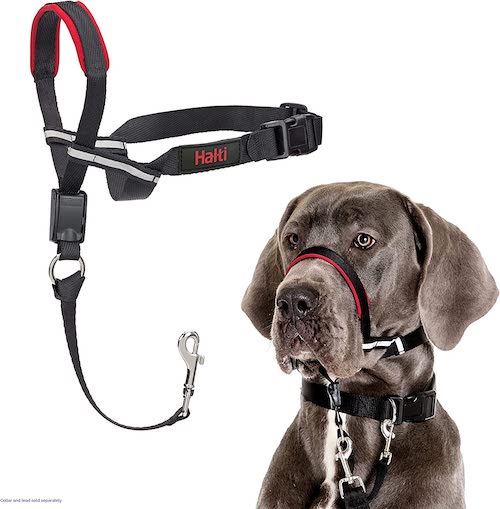
Halti Opti-Fit Head Collar
Many consider the Halti a more comfortable head halter than the Gentle Leader. If your dog will tolerate wearing one, a Halti can help redirect their pulling.
Because they tend to fit more loosely than a Gentle Leader, some dogs find Haltis more tolerable to wear. With an adjustable noseband and cheek strap, the Halti Head Collar fits a range of dog sizes. Again, some dogs won’t like the feel of a head halter, so you’ll need patience and gradual desensitization to acclimate your dog to wearing one.
Features we like:
- Padded noseband
- Won’t interfere with panting, eating, or drinking
- Helps stop pulling
- Adjustable fit for a range of sizes and shapes
Things to consider:
- May take time and training for dogs to accept wearing this
What about Shock Collars, E-Collars, or Bark Collars?
Many pet parents are frustrated by their dog’s barking, pulling, or reactivity and understandably want quick relief from these behaviors. However, using a device that causes pain or discomfort, such as a shock collar, e-collar, bark collar, prong collar, or choke collar, is likely to create more problems than they solve.
Collars that cause pain or discomfort are dangerous because of the pressure they apply on a dog’s trachea, neck, and spine. They can also constrict blood flow to the brain. Not to mention that when used on a dog that may be reacting out of fear, they make the world more scary by adding pain on top of an already frightening situation.
Using an e-collar or prong collar on a dog that pulls often leads to reactivity (barking and lunging at other dogs and people) because the dog is uncertain what in the environment is triggering their pain.
The best deterrent to barking, pulling, and reactive dogs is positive reinforcement training. These methods are based on science instead of on the principles of pain, fear, and intimidation.
If your dog is having difficulty on a leash or with barking, contact a certified dog trainer or veterinary behaviorist. Never work with a trainer who uses “balanced” techniques or claims they can “fix” your dog within a short period of time.
The bottom line
Using the right training collar, harness, or leash can help you and your dog reach your goal of walking calmly on a leash. Each of these options, however, is simply a method of communication, not a form of control.
Proper training is the most effective and long-lasting way to prevent unwanted behaviors. If you need support or tips about how to best train your puppy or dog to walk on a leash, consult a professional for help.
How We Chose
The training products featured here were selected based on a combination of our own hands-on testing, a comprehensive look at customer reviews, and interviews with veterinary experts. We prioritized durability and adjustability. Additionally, we considered advantageous training features like escape-proof straps, anti-chafing materials, and anti-pull clips. We’re also guided by the experience of living and playing alongside our own much-loved and strongly opinionated pets, who are never stingy with their feedback.
